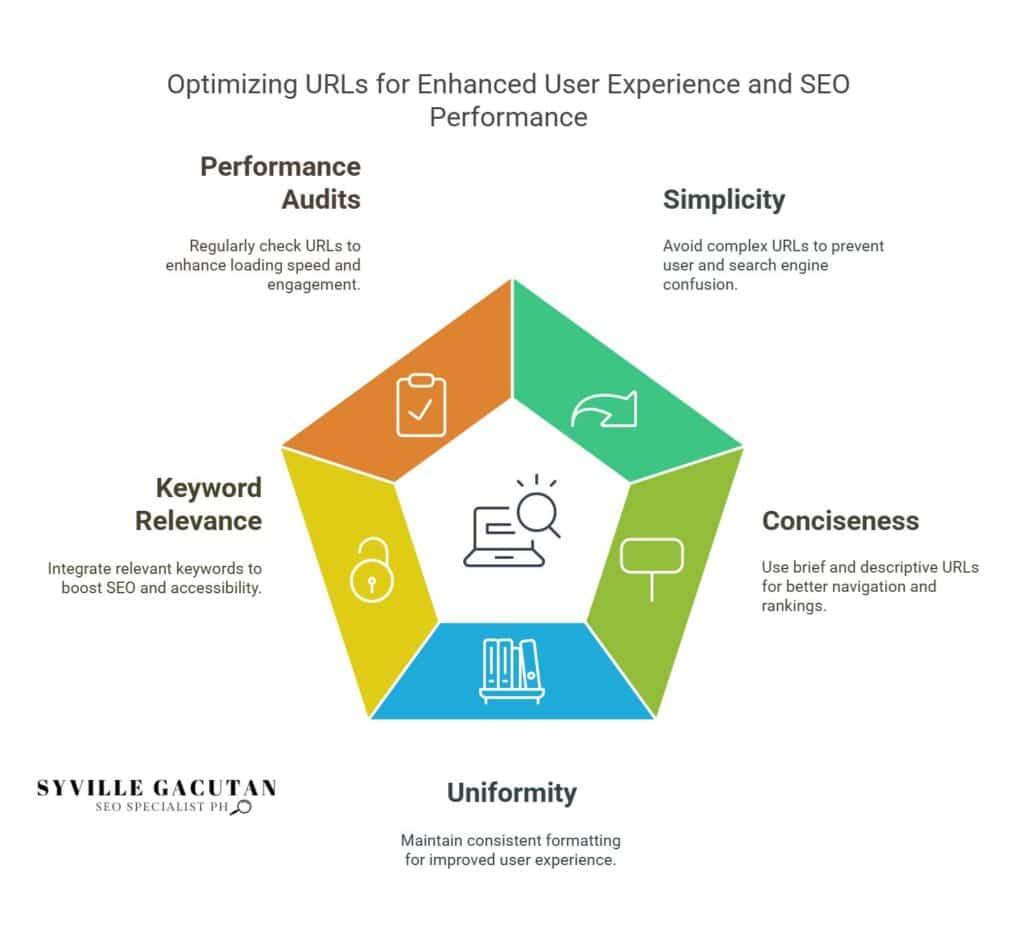
For those starting out it’s important to steer clear of typical errors with website addresses. This will boost search engine visibility and improve the experience for visitors. Key errors include using complex or excessively long URLs, which impede understanding and affect rankings. It is crucial to maintain clear structures by utilizing concise, descriptive keywords that reflect page content effectively. Dynamic parameters often lead to confusion and reduced search engine visibility; opt for static, meaningful URLs instead. Additionally, proper utilization of hyphens, rather than underscores, enhances readability. Always ensure URLs are simple, intuitive, and consistent in format. Regularly checking performance through audits and analytics software helps spot problems. This provides understanding to enhance URL strategies.
Key Takeaways
- Steer clear of excessively intricate web addresses containing superfluous dynamic elements. These can perplex users and search engines alike.
- Ensure URLs are concise and descriptive, avoiding vagueness that hinders navigation and search rankings.
- Apply uniform formatting to web addresses. This enhances user experience by improving navigation flow and maintaining coherence.
- Incorporate relevant keywords without stuffing, enhancing SEO and user accessibility.
- Regularly audit URL performance to address slow-loading issues and improve user engagement.

Importance of URL Structure

A well-organized URL structure serves as a foundational element for effective SEO and user experience. The importance of structuring URLs cannot be overstated, as they significantly contribute to a website’s visibility and navigability. A clean, logical URL structure not only aids search engines in indexing your site efficiently but also enhances user engagement by providing clear and intuitive navigation paths.
One of the common mistakes in website design is neglecting the URL structure, which can lead to a labyrinth of confusing links that deter both users and search engines. Such errors often include overly complex URLs, excessive use of special characters, or lack of descriptive keywords, all of which can negatively impact a website’s search engine ranking and user trust. Ensuring that URLs are concise, relevant, and descriptive is vital in avoiding these pitfalls.
Incorporating the importance of URL structure into the website design process involves planning and foresight. Avoid URLs that change constantly. These URLs frequently contain random characters and numbers. Instead use fixed URLs that clearly describe the page content.
Moreover, maintaining consistency in URL formatting across the site can help avoid confusion and promote a coherent user experience.
Web designers need to focus on making URLs simple clear, & relevant. This will help get the most out of a well-structured URL. By doing so, they can effectively avoid common mistakes associated with poor URL structures, thereby enhancing both SEO outcomes and user satisfaction.
Ultimately, a strategically crafted URL structure plays a pivotal role in the overall success of a website.
Understanding URL Components

URLs, or Uniform Resource Locators, are composed of several key components that collectively direct users to specific online resources. Understanding these components is crucial for enhancing user experience and ensuring efficient navigation. A typical URL consists of the protocol, domain name, path, query string, and fragment identifier. Each element plays a distinct role and must be used correctly to avoid common mistakes.
The protocol, such as “http” or “https”, indicates how data is transferred between the browser and server. Using “https” is recommended as it provides a secure connection, enhancing user trust.
The domain name, like “example.com“, serves as the primary identifier of the website and should be memorable and concise to facilitate easy access.
The path follows the domain and directs to specific pages or resources within the site. A clear and descriptive path is vital, as it informs users and search engines about the content they can expect. Avoid these mistakes by keeping paths short and meaningful, thus improving user experience and search engine optimization.
Query strings, which appear after a question mark in a URL, allow the transmission of additional data parameters. While useful, they should be minimized to prevent confusion and maintain URL simplicity.
Lastly, the fragment identifier, indicated by a hash (#), points to a specific section within a page. It can enhance navigation by directly leading users to relevant content.
Understanding these components and their correct usage is essential for creating URLs that are both user-friendly and effective. By adhering to best practices, one can avoid common pitfalls and improve the overall clarity and functionality of URLs.
Choosing Relevant Keywords

Effectively choosing relevant keywords is a critical step in crafting URLs that resonate with both users and search engines. The process involves understanding the core intent of the page content and ensuring that the selected keywords align seamlessly with that intent. This not only enhances the search engine optimization (SEO) efforts but also improves user accessibility by making URLs more intuitive and easier to remember.
In the realm of common web design, failing to prioritize relevant keywords is among the frequent mistakes beginners make, often leading to URLs that are either too generic or overly complex.
To successfully choose relevant keywords, beginners must first analyze user data to gain insights into the terms their target audience frequently searches for. This data-driven approach allows for the identification of high-impact keywords that can significantly boost visibility and engagement.
In addition, leveraging keyword research tools can offer invaluable assistance in discerning keyword relevance and popularity, thus aiding in the selection process.
Another pitfall to avoid is keyword stuffing, which can detract from both user experience and search engine rankings. Instead, focus on incorporating a concise set of keywords that accurately reflect the page’s content and purpose.
This practice not only supports SEO efforts but also enhances the accessibility of URLs for diverse user groups, including those who rely on assistive technologies.
Keeping URLs Descriptive

Crafting descriptive URLs plays a pivotal role in enhancing both user experience and search engine understanding. A well-structured URL provides a clear and concise pathway for users and search engines to comprehend the content of a webpage.
However, common mistakes such as vague or non-descriptive URLs can hinder effective navigation and negatively impact search engine rankings. Utilizing best practices ensures URLs are not only informative but also user-friendly, paving the way for improved engagement and discoverability.
Descriptive URLs act as a roadmap, guiding users to their desired content without confusion. When URLs are ambiguous or cluttered with unnecessary characters, it can lead to user frustration and potential loss of traffic.
By avoiding these mistakes and adhering to best practices, one can create URLs that are both functional and aesthetically pleasing.
Here are some best practices for creating descriptive URLs:
- Use meaningful keywords: Incorporate relevant keywords that accurately represent the content of the page, making it easier for users and search engines to understand its purpose.
- Maintain simplicity and clarity: Keep URLs short and straightforward, avoiding complex words or jargon that may confuse users or search engines.
- Employ hyphens for separation: Use hyphens instead of underscores to separate words within the URL, as this aids readability and is favored by search engines for indexing.
In following these guidelines, the navigation experience is streamlined, allowing for seamless access to content while adhering to the best practices for SEO.
This approach not only mitigates common mistakes but also enhances the overall efficacy of a website’s architecture.
Avoiding Dynamic Parameters

While dynamic parameters can offer flexibility in URL structures, they often pose challenges for search engine optimization and user experience. Dynamic parameters, such as those used to track sessions or user preferences, can lead to complex and lengthy URLs. These URLs can be difficult for search engines to crawl and index effectively, often resulting in duplicate content issues or diluted ranking signals.
Additionally, users may find these URLs unappealing and harder to share or remember, ultimately affecting website performance.
One common mistake beginners make is relying heavily on dynamic parameters without considering their impact on the overall URL structure. In website design, it is crucial to maintain clean and descriptive URLs that are both user-friendly and search engine-friendly.
While dynamic parameters might seem convenient for passing information between pages, they can complicate the URL structure, making it less intuitive and accessible.
To avoid using dynamic parameters unnecessarily, consider alternative methods of URL structuring. For instance, meaningful and static URLs can be crafted by implementing URL rewriting techniques. This approach not only enhances readability but also improves search engine optimization.
URLs should be concise, relevant, and reflective of the page content, making it easier for both search engines and users to understand the page’s purpose.
Using Hyphens for Separation
When structuring URLs, using hyphens for separation is a best practice that enhances readability and search engine optimization. URLs serve as the primary link between a user and a website’s content, and ensuring they are clear and navigable is crucial.
One of the common mistakes beginners make is opting for underscores or omitting separators altogether, which can lead to confusion and negatively impact both user experience and SEO.
Hyphens are preferable for several reasons:
- Improved Readability: Hyphens act as natural separators, making URLs easier for users to read and understand. This is especially important for common website structures where clarity is key.
- SEO Benefits: Search engines like Google recognize hyphens as word separators, which helps in accurately indexing the website’s content. This plays a significant role in enhancing a website’s visibility in search results.
- Consistent Navigation: A consistent use of hyphens aids in predictable navigation for users. This consistency reduces the likelihood of errors when users manually type URLs or share links.
For beginners looking to avoid common pitfalls, embracing the use of hyphens is a straightforward and effective strategy. It not only improves the user experience by providing a clear and logical structure but also aligns with search engine algorithms, which prioritize user-friendly URLs.
Maintaining URL Length
Ensuring optimal URL length is crucial for both user experience and search engine optimization. A concise and clear URL not only enhances the navigability of a website but also plays a significant role in search engine rankings. For beginners developing their websites, understanding the importance of maintaining an appropriate URL length can prevent several common mistakes that might otherwise hinder their online presence.
A common mistake is creating URLs that are excessively long and complex. Beginners often fall into the trap of overloading URLs with unnecessary words or characters, which can lead to confusion and difficulty for users in remembering or sharing the link. Moreover, search engines prefer URLs that are straightforward and relevant, as they are easier to index and rank. Keeping URLs concise helps in conveying the page’s purpose without overwhelming the reader or the search engine.
To avoid these common pitfalls, it is advisable for beginners to focus on simplicity and relevance when crafting URLs. Start by identifying the key terms that encapsulate the page’s content and incorporate them into the URL. This not only helps in maintaining a reasonable URL length but also aligns with SEO best practices, enhancing discoverability.
Additionally, while crafting URLs, avoid using excessive parameters or dynamic elements that do not add value to the user or search engines. Instead, aim for clarity and precision, ensuring that each component of the URL serves a purpose. By doing so, beginners can effectively optimize their website’s URLs, leading to improved user interaction and search engine performance.
Monitoring URL Performance

To optimize a website’s effectiveness, monitoring URL performance is essential for identifying areas of improvement and ensuring that URLs contribute positively to both user experience and search engine rankings. By keeping a close eye on how URLs perform, webmasters can pinpoint common mistakes that may otherwise go unnoticed, ultimately enhancing the overall functionality and visibility of their sites.
Understanding URL performance involves evaluating factors such as load speed, click-through rates, and user engagement, all of which are crucial for maintaining a competitive edge in digital environments.
Common mistakes in URL performance monitoring often stem from neglecting these critical aspects. URLs that load slowly, for instance, can lead to increased bounce rates, negatively impacting user satisfaction and search engine optimization (SEO). Additionally, failing to track click-through rates can result in missed opportunities for engagement, as inadequate URLs might not attract the desired user interactions.
To effectively monitor URL performance and avoid common mistakes, consider the following strategies:
- Utilize Analytics Tools: Employ tools such as Google Analytics to track essential metrics like page views, bounce rates, and session duration, providing insights into URL performance.
- Conduct Regular Audits: Regularly audit your URLs to identify underperforming links, ensuring they are optimized for both speed and relevance.
- Test Across Devices: Ensure that URLs are responsive and perform consistently across various devices, as mobile performance is integral to overall user experience.
Final Thoughts
Avoiding common URL mistakes is essential for both SEO and user experience. By keeping URLs concise, descriptive, and free from unnecessary complexity or dynamic parameters, you enhance your site’s search engine visibility and make it easier for users to navigate. Consistency in format and regular audits will help ensure that your URLs remain effective over time, contributing to improved rankings and user engagement. Simple, intuitive URLs are a cornerstone of a well-optimized website.
If you need expert guidance in optimizing your website’s URL structure and enhancing your overall SEO strategy, reach out to Syville Gacutan, an experienced SEO Specialist in the Philippines. Let Syville help you achieve higher search rankings and a seamless user experience. Contact today to get started!